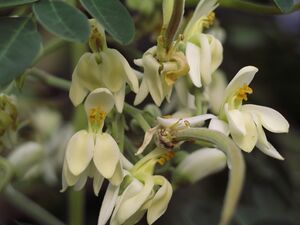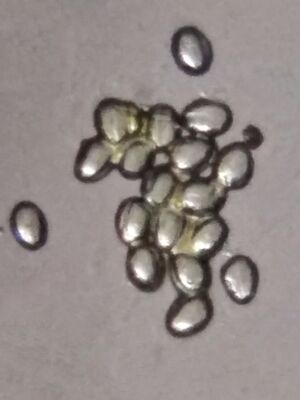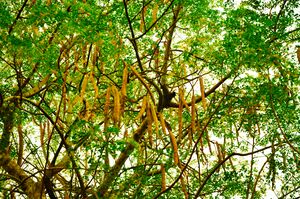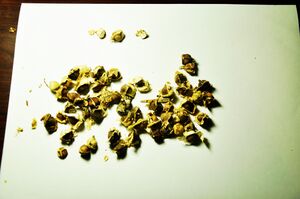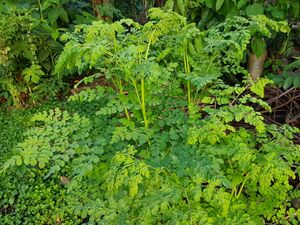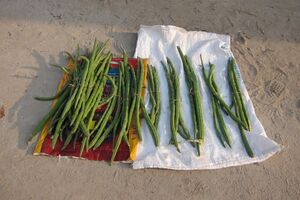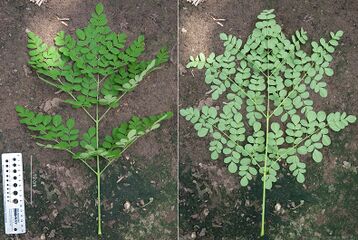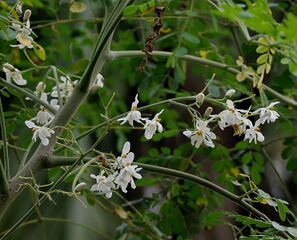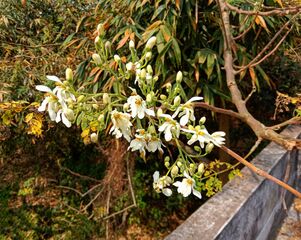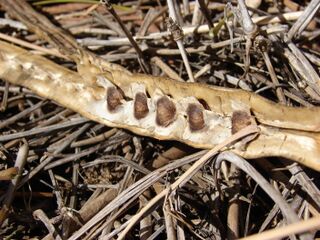بان زيتي
| بان زيتي | |
|---|---|
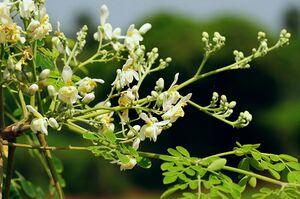
| |
| التصنيف العلمي | |
| أصنوفة غير معروفة (أصلحها): | Moringa |
| Species: | Template:Taxonomy/MoringaM. oleifera
|
| Binomial name | |
| Template:Taxonomy/MoringaMoringa oleifera | |
| Synonyms[1] | |
| |
اسمها العلمي هو Moringa oleifera, ولها عدة أسماء عربية, مثل اليسار, والبان, والثوم البري, كما تسمى أحيانًا بشخرة الروّاق’ لاحتواء بذور ثمارها على مركبات زيتية لها القدرة علي تجميع وتسريب المواد العالقة بالماء. فيصير رائقًا صالحًا للشرب. ثم ان تلك الزيوت إلى الطعام الأدمي. كما عرفت زيوتها لصناعة العطور, ومستحضرات التجميل, لقدرتها لتثبيت بعض المكونات الطيارة. والهند هي الموطن الأصلي للمورنجا, حيث تستخدم أزهارها وأوراقها كطعام, وفي التداوي. وهي أيضًا معروفة في السودان, حيث تستخدم في (ترويق) العسل, وفي الفلبين, حيث تستخرج من جزورها مادة دوائية. طاردة للديدان الخيطية, وقد انتشرت أشجار المورنجا في جنوب مصر, وشمال السودان, وحتي في بعض مناطق الجزيرة العربية, خصوصًا في الحجاز.
الوصف
أشجار المورنجا سريعة النمو, وهي من الأشجار متساقطة الأوراق, وتظهر أزهارها في شهر مايو, قبل خروج الأوراق الجديدة. وتنتظم الأزهار في نورات, وثمارها عبارة عن قرون, فيأخذ القطاع العرضي فيها هيئة مثلث. تنجح زراعة أشجار المورنجا في كل من الأراضي الرملية والطينية, وهي تحتاج الي نظام صرف جيد. من هنا جاء أنتشارها الواسع على ضفاف الأنهار, والمجاري المائية, وفي الحدائق المنزلية, وحول الحقول, وتتميز المورنجا بمقاومتها الشديدة للجفاف. تزرع أشجار المورنجا بطريقتين, خضريًا أو بالبذور, فأما الزراعة الخضرية, فتتم باستخدام (عُقل), يزيد طولها على المتر. اما في زراعة البذور, يتم الإنبات في أماكن ظليلة, حيث غالبًا ما توضع البذور في أكياس مثقبة, وتغرس في التربة, علي عمق 7 سم. وعندما يصل عمر الشتلات إلى ثلاثة شهور, يمكن تداولها ونقلها لموقعها الدائم, الجدير بالذكر, أن إنتاج المورنجا من الثمار يبدأ بعد ستة شهور من الزراع.
السمية
Toxicity data in humans is limited, although lab studies indicate that certain compounds in the bark and roots or their extracts may cause adverse effects when consumed in excess.[2] Supplementation with M. oleifera leaf extract is potentially toxic at levels exceeding 3,000 milligram/kg of body weight but safe at levels below 1,000 mg/kg.[3] M. oleifera may interfere with prescription drugs affecting cytochrome P450 (including CYP3A4) and may inhibit the anti-hyperglycemic effect of sitagliptin.[2]
استخدامات
M. oleifera has numerous applications in cooking throughout its regional distribution. Edible parts of the plant include the whole leaves (leaflets, stalks and stems); the immature, green fruits or seed pods; the fragrant flowers; and the young seeds and roots.[4]
التغذية
| القيمة الغذائية لكل 100 g (3.5 oz) | |
|---|---|
| الطاقة | 64 kcal (270 kJ) |
8.28 g | |
| ألياف غذائية | 2.0 g |
1.40 g | |
9.40 g | |
| الڤيتامينات | |
| مكافئ ڤيتامين أ | (47%) 378 μg |
| ثيامين (B1) | (22%) 0.257 mg |
| ريبوفلاڤين (B2) | (55%) 0.660 mg |
| نياسين (B3) | (15%) 2.220 mg |
(3%) 0.125 mg | |
| ڤيتامين B6 | (92%) 1.200 mg |
| فولات (B9) | (10%) 40 μg |
| Vitamin C | (62%) 51.7 mg |
| آثار فلزات | |
| كالسيوم | (19%) 185 mg |
| حديد | (31%) 4.00 mg |
| الماغنسيوم | (41%) 147 mg |
| المنگنيز | (17%) 0.36 mg |
| فوسفور | (16%) 112 mg |
| پوتاسيوم | (7%) 337 mg |
| صوديوم | (1%) 9 mg |
| زنك | (6%) 0.6 mg |
| مكونات أخرى | |
| ماء | 78.66 g |
| |
| Percentages are roughly approximated using US recommendations for adults. Source: USDA Nutrient Database | |
| القيمة الغذائية لكل 100 g (3.5 oz) | |
|---|---|
| الطاقة | 37 kcal (150 kJ) |
8.53 g | |
| ألياف غذائية | 3.2 g |
0.20 g | |
2.10 g | |
| الڤيتامينات | |
| مكافئ ڤيتامين أ | (1%) 4 μg |
| ثيامين (B1) | (5%) 0.0530 mg |
| ريبوفلاڤين (B2) | (6%) 0.074 mg |
| نياسين (B3) | (4%) 0.620 mg |
(16%) 0.794 mg | |
| ڤيتامين B6 | (9%) 0.120 mg |
| فولات (B9) | (11%) 44 μg |
| Vitamin C | (170%) 141.0 mg |
| آثار فلزات | |
| كالسيوم | (3%) 30 mg |
| حديد | (3%) 0.36 mg |
| الماغنسيوم | (13%) 45 mg |
| المنگنيز | (12%) 0.259 mg |
| فوسفور | (7%) 50 mg |
| پوتاسيوم | (10%) 461 mg |
| صوديوم | (3%) 42 mg |
| زنك | (5%) 0.45 mg |
| مكونات أخرى | |
| ماء | 88.20 g |
| |
| Percentages are roughly approximated using US recommendations for adults. Source: USDA Nutrient Database | |
Various parts of moringa are edible:[5]
- Immature seed pods, called "drumsticks"
- Leaves
- Mature seeds
- Oil pressed from seeds
- Flowers
- Roots
Nutritional content of 100 g of fresh M. oleifera leaves (about 5 cups) is shown in the table (USDA data).
The leaves are the most nutritious part of the plant, being a significant source of B vitamins, vitamin C, provitamin A as beta-carotene, vitamin K, manganese, and protein.[6][7] When compared with common foods particularly high in certain nutrients per 100 g fresh weight, cooked moringa leaves are considerable sources of these same nutrients. Some of the calcium in moringa leaves is bound as crystals of calcium oxalate.[8] Oxalate levels may vary from 430 mg/100g to 1050 mg/100g,[9] compared to the oxalate in spinach (average 750 mg/100g).[10]
البذور
The seeds can be removed from mature pods, cut, and cooked for consumption.[11]
In Nigeria, the seeds are prized for their bitter flavor; they are commonly added to sauces or eaten as a fried snack. The edible seed oil may be used in condiments or dressings.[4]
Ground, debittered moringa seed is suitable as a fortification ingredient to increase the protein, iron and calcium content of wheat flours.[4][12][13]
قرون الفاكهة
The young, slender fruits, commonly known as "drumsticks", are often prepared as a culinary vegetable in South Asia. They are prepared by parboiling, commonly cut into shorter lengths, and cooked in a curry or soup until soft.[14] The taste is described as reminiscent of asparagus,[15] with a hint of green beans, though sweeter due to the immature seeds contained inside.[16] The seed pods, even when cooked by boiling, remain high in vitamin C[17] (which may be degraded variably by cooking), and are also a good source of dietary fiber, potassium, magnesium, and manganese.[17]
In India and Bangladesh, drumstick curries are commonly prepared by boiling immature pods to the desired level of tenderness in a mixture of coconut milk and spices (such as poppy or mustard seeds).[4] The fruit is a common ingredient in dals and lentil soups, such as drumstick dal and sambar, where it is pulped first, then simmered with other vegetables and spices like turmeric and cumin. Mashed drumstick pulp commonly features in bhurta, a mixture of lightly fried or curried vegetables.[4]
Because the outer skin is tough and fibrous, drumsticks are often chewed to extract the juices and nutrients, with the remaining fibrous material discarded. Others describe a slightly different method of sucking out the flesh and tender seeds and discarding the tube of skin.[16]
زيت البذور
Mature seeds yield 38–40% edible oil called ben oil from its high concentration of behenic acid. The refined oil is clear and odorless, and resists rancidity. The young fruits can be boiled and the oil skimmed off the water surface.[11] The seed cake remaining after oil extraction may be used as a fertilizer or as a flocculent to purify water.[18] Moringa seed oil also has potential for use as a biofuel.[19]
الجذور
The roots are shredded and used as a condiment with sharp flavor qualities deriving from significant content of polyphenols.[20]
الأوراق
Edible raw or cooked (depending on hardiness),[11] the leaves can be used in many ways. They are perhaps most commonly added to clear broth-based soups, such as the Filipino dishes tinola and utan. Tender moringa leaves, finely chopped, are used as garnish for vegetable dishes and salads, such as the Kerala dish thoran. It is also used in place of or along with coriander.[4] The leaves are also cooked and used in ways similar to spinach, and are commonly dried and crushed into a powder for soups and sauces.[5]
For long-term use and storage, moringa leaves may be dried and powdered to preserve their nutrients. Sun, shade, freeze and oven drying at 50–60 °C are all acceptable methods, albeit variable in their retention efficacy of specific micro- and macronutrients.[21][22] The powder is commonly added to soups, sauces and smoothies.[4] Owing to its high nutritional density, moringa leaf powder is valued as a dietary supplement and may be used to enrich food products ranging from dairy, such as yogurt and cheese,[12] to baked goods, such as bread and pastries,[4][12] with acceptable sensory evaluation.[4][12]
Dunt-dalun chin-yei, Burmese drumstick sour soup
Sabaw sa kalamunggay, a Visayan fish soup from the Philippines with moringa leaves
-- قد تساعد تقنية زهيدة الثمن في خفض الأمراض المنقولة عن طريق المياه في دول العالم النامية، وذلك باستخدام بذور شجرة مورينجا أوليفرا. وأثبت التجارب حول تلك التقنية، التي نشرت في دورية "البروتوكولات الحالية في علم الأحياء" أن بذور المورينجا ساعدت في إنتاج مياه نقية خالية من البكتريا، من مياه غير معالجة، بنسبة ما بين 90 في المائة إلى 99 في المائة. ويقدر أن مليار شخص في كل من آسيا وأفريقيا وأمريكا اللاتينية، يعتمدون تماماً على مصادر مياه سطحية غير منقاة أو معالجة لتلبية احتياجياتهم اليومية من المياه، يتوفى منهم قرابة مليوني شخص سنوياً جراء أمراض تسببها تلك المياه الملوثة، معظمهم من الاطفال دون سن الخامسة.
ويعتقد مايكل لي، باحث في "كليرينغهاوس" وهي منظمة كندية معنية بالتقصي عن وتطبيق تقنيات زهيدة الثمن لتنقية المياه، أن بالإمكان قطع شوط كبير نحو توفير مياه نقية وذلك باستخدام بذور شجرة مورينجا أوليفرا Moringa oleifera، وهي من عائلة Moringaceae. وتنمو الشجرة في أفريقيا وأمريكا الوسطى والجنوبية وشبه القارة الهندية وجنوب شرق آسيا، وتعتبر واحدة من الأشجار المفيدة للغاية"، فهي مقاومة مقاومة للجفاف، ويستخدم زيتها في الإضاءة والطهي، وفي خواص تحسين التربة كما أن لها استخدامات طبية وفوائد غذائية عالية. ويمكن استخدام بذور الشجر، بعد سحقها كمنقي للمياه وتحسين قابليته للاستهلاك البشري، غير أن التقنية التي لاتزال غير معروفة على نطاق واسع حتى في المناطق التي يكثر فيها نمو المورينجا.
وقال لي: "هذه التقنية لا تمثل حلا شاملا لخطر الأمراض المنقولة عن طريق المياه"، إلا أنها قد تخفض ولحد كبير من الوفيات الناجمة عن المياه غير المعالجة، والتي كانت تعد من أبرز مسببات الوفاة خلال القرن التاسع عشر. ويذكر أن لاشجار المورينجا القدرة على النمو حتى في الأراضي القاحلة وغير الخصبة كما ان احتياجاتها المائية قليلة مقارنة بالأشجار الأخرى، وتتميز بأنها شجرة سريعة النمو دائمة الخضرة حتى في مواسم الجفاف.
الطب التقليدية والأبحاث
The bark, sap, roots, leaves, seeds and flowers are used in traditional medicine.[5][23]
Research has examined how it might affect blood lipid profiles and insulin secretion.[2] Extracts from leaves contain various polyphenols, which are under basic research to determine their potential effects in humans.[24] Despite considerable preliminary research to determine if moringa components have bioactive properties, there is no high-quality evidence to indicate that it has any effect on health or diseases.[2]
استخدامات أخرى
In developing countries, moringa has the potential to improve nutrition, boost food security, foster rural development, and support sustainable landcare.[5][25] It may be used as forage for livestock, a micronutrient liquid, a natural anthelmintic, and possible adjuvant.[26][27]
Moringa trees have been used to combat malnutrition, especially among infants and nursing mothers.[5] Since moringa thrives in arid and semiarid environments, it may provide a versatile, nutritious food source throughout the year in various geographic regions.[28] Some 140 organizations worldwide have initiated moringa cultivation programs to lessen malnutrition, purify water, and produce oils for cooking.[5]
Moringa oleifera leaf powder was as effective as soap for hand washing when wetted in advance to enable anti-septic and detergent properties from phytochemicals in the leaves.[29] Moringa oleifera seeds and press cake have been implemented as wastewater conditioners for dewatering and drying fecal sludge.[30]
Moringa seed cake, obtained as a byproduct of pressing seeds to obtain oil, is used to filter water using flocculation to produce potable water for animal or human consumption.[31][32] Moringa seeds contain dimeric cationic proteins[33] which absorb and neutralize colloidal charges in turbid water, causing the colloidal particles to clump together, making the suspended particles easier to remove as sludge by either settling or filtration. Moringa seed cake removes most impurities from water. This use is of particular interest for being nontoxic and sustainable compared to other materials in moringa-growing regions where drinking water is affected by pollutants.[32]
معرض صور
Branch of a fully grown moringa tree with flowers and leaves (West Bengal)
Dry open moringa pod on the ground showing winged seeds (Hawaii)
المراجع
- ^ Olson, M. E. (2010). Flora of North America Committee (ed.). eFlora summary: Moringaceae: Drumstick Family. Flora of North America, North of Mexico. Vol. 7. New York and Oxford. pp. 167–169.
{{cite book}}: CS1 maint: location missing publisher (link) - ^ أ ب ت ث "Moringa oleifera". Memorial Sloan-Kettering Cancer Center. Retrieved 2014-02-27.
- ^ Asare, GA; Nyarko, A (2012). "Toxicity potentials of the nutraceutical Moringa oleifera at supra-supplementation levels". Journal of Ethnopharmacology. 139 (1): 265–272. doi:10.1016/j.jep.2011.11.009. PMID 22101359.
- ^ أ ب ت ث ج ح خ د ذ Lim, TK (2012). "Moringa oleifera". Edible Medicinal And Non Medicinal Plants. Vol. 3, Fruits. Springer Netherlands. pp. 453–485. ISBN 978-94-007-2534-8.
- ^ أ ب ت ث ج ح خطأ استشهاد: وسم
<ref>غير صحيح؛ لا نص تم توفيره للمراجع المسماةcabi - ^ "Horseradish-tree, leafy tips, cooked, boiled, drained, without salt". Nutritiondata.com. Condé Nast. 2012. Retrieved 6 May 2013.
- ^ Peter, K.V. (2008). Underutilized and Underexploited Horticultural Crops:, Volume 4. New India Publishing. p. 112. ISBN 978-81-89422-90-5.
- ^ Olson, M. E.; Carlquist, S. (2001). "Stem and root anatomical correlations with life form diversity, ecology, and systematics in Moringa (Moringaceae)". Botanical Journal of the Linnean Society. 135 (4): 315–348. doi:10.1111/j.1095-8339.2001.tb00786.x.
- ^ Leone A, Spada A, Battezzati A, Schiraldi A, Aristil J, Bertoli S (June 2015). "Cultivation, Genetic, Ethnopharmacology, Phytochemistry and Pharmacology of Moringa oleifera Leaves: An Overview". Int J Mol Sci. 16 (6): 12791–835. doi:10.3390/ijms160612791. PMC 4490473. PMID 26057747.
- ^ Holmes RP, Kennedy M (April 2000). "Estimation of the oxalate content of foods and daily oxalate intake". Kidney Int. 57 (4): 1662–7. doi:10.1046/j.1523-1755.2000.00010.x. PMID 10760101.
- ^ أ ب ت The Complete Guide to Edible Wild Plants (in الإنجليزية الأمريكية). United States Department of the Army. New York: Skyhorse Publishing. 2009. p. 60. ISBN 978-1-60239-692-0. OCLC 277203364.
{{cite book}}: CS1 maint: others (link) - ^ أ ب ت ث Oyeyinka, AT; Oyeyinka, SA (2018). "Moringa oleifera as a food fortificant: Recent trends and prospects". Journal of the Saudi Society of Agricultural Sciences. 17 (2): 127–136. doi:10.1016/j.jssas.2016.02.002.
- ^ Chinma, C; Abu, J; Akoma, S (2014). "Effect of germinated tigernut and moringa flour blends on the quality of wheat-based bread". Journal of Food Processing and Preservation. 38 (2): 721–727. doi:10.1111/jfpp.12023.
- ^ Schneider, Elizabeth (2001). Vegetables from Amaranth to Zucchini: The Essential Reference. HarperCollins. p. 318. ISBN 978-0-688-15260-4.
- ^ Holmer, R; Linwattana, G; Nath, P; Keatinge, JDH (2013). SEAVEG 2012: High Value Vegetables in Southeast Asia: Production, Supply and Demand. World Vegetable Center. ISBN 978-9290582007.
- ^ أ ب "My Mom Cooked Moringa Before It Was A Superfood" (Podcast). NPR. 21 September 2015. Retrieved 2017-07-08.
- ^ أ ب "Horseradish-tree, pods, cooked, boiled, drained, without salt". Nutritiondata.com. Condé Nast. 2012. Retrieved 6 May 2013.
- ^ Lea, Michael (2010). Bioremediation of Turbid Surface Water Using Seed Extract from Moringa oleifera Lam. (Drumstick) Tree. Vol. Chapter 1. pp. Unit1G.2. doi:10.1002/9780471729259.mc01g02s16. ISBN 978-0471729259. PMID 20131221. S2CID 30231607.
{{cite book}}:|journal=ignored (help) - ^ Rashid, Umer; Anwar, Farooq; Moser, Bryan R.; Knothe, Gerhard (2008). "Moringa oleifera oil: A possible source of biodiesel". Bioresource Technology. 99 (17): 8175–9. doi:10.1016/j.biortech.2008.03.066. PMID 18474424.
- ^ Atawodi, S. E.; Atawodi, J. C.; Idakwo, G. A.; Pfundstein, B; Haubner, R; Wurtele, G; Bartsch, H; Owen, R. W. (2010). "Evaluation of the polyphenol content and antioxidant properties of methanol extracts of the leaves, stem, and root barks of Moringa oleifera Lam". Journal of Medicinal Food. 13 (3): 710–6. doi:10.1089/jmf.2009.0057. PMID 20521992.
- ^ Adenike AB (2014). "The effects of drying on some nutrients of Moringa oleifera leaves" (PDF). Annals – Food Science and Technology. 15 (2): 246–250. ISSN 2344-4916.
- ^ Ali, A; Yusof, YA; Chin, NL; Ibrahim, MN (2017). "Processing of Moringa leaves as natural source of nutrients by optimization of drying and grinding mechanism". Journal of Food Process Engineering. 40 (e12583): e12583. doi:10.1111/jfpe.12583.
- ^ NPCS Board (2012). Handbook on Agro Based Industries (2nd Revised ed.). Niir Project Consultancy Services. p. 66. ISBN 978-9381039120.
- ^ Sreelatha, S.; Padma, P. R. (2009-11-11). "Antioxidant activity and total phenolic content of Moringa oleifera leaves in two stages of maturity". Plant Foods for Human Nutrition. 64 (4): 303–311. doi:10.1007/s11130-009-0141-0. PMID 19904611. S2CID 8801347.
- ^ National Research Council (2006-10-27). "Moringa". Lost Crops of Africa: Volume II: Vegetables. Lost Crops of Africa. Vol. 2. National Academies Press. ISBN 978-0-309-10333-6. Retrieved 2008-07-15.
- ^ Makkar HP, Francis G, Becker K (2007). "Bioactivity of phytochemicals in some lesser-known plants and their effects and potential applications in livestock and aquaculture production systems". Animal. 1 (9): 1371–91. doi:10.1017/S1751731107000298. PMID 22444893.
- ^ Mahajan SG, Mali RG, Mehta AA (2007). "Protective effect of ethanolic extract of seeds of Moringa oleifera Lam. against inflammation associated with development of arthritis in rats". J Immunotoxicol. 4 (1): 39–47. doi:10.1080/15476910601115184. PMID 18958711.
- ^ "Traditional crops: Moringa". Food and Agriculture Organization of the United Nations. 2021. Retrieved 12 April 2021.
- ^ Torondel, B.; Opare, D.; Brandberg, B.; Cobb, E.; Cairncross, S. (2014). "Efficacy of Moringa oleifera leaf powder as a hand- washing product: A crossover controlled study among healthy volunteers". BMC Complementary and Alternative Medicine. 14: 57. doi:10.1186/1472-6882-14-57. PMC 3930822. PMID 24528477.
{{cite journal}}: CS1 maint: unflagged free DOI (link) - ^ Gold, Moritz; Dayer, Pauline; Faye, Marie Christine Amie Sene; Clair, Guillaume; Seck, Alsane; Niang, Seydou; Morgenroth, Eberhard; Strande, Linda (2016-04-18). "Locally produced natural conditioners for dewatering of faecal sludge". Environmental Technology. 37 (21): 2802–2814. doi:10.1080/09593330.2016.1165293. PMC 5020332. PMID 26984372.
- ^ Ndabigengesere, Anselme; Narasiah, K.Subba; Talbot, Brian G. (February 1995). "Active agents and mechanism of coagulation of turbid waters using Moringa oleifera". Water Research. 29 (2): 703–710. doi:10.1016/0043-1354(94)00161-Y.
- ^ أ ب Hellsing, Maja S.; Kwaambwa, Habauka M.; Nermark, Fiona M.; Nkoane, Bonang B.M.; Jackson, Andrew J.; Wasbrough, Matthew J.; Berts, Ida; Porcar, Lionel; Rennie, Adrian R. (2013). "Structure of flocs of latex particles formed by addition of protein from Moringa seeds". Colloids and Surfaces A: Physicochemical and Engineering Aspects. 460: 460–467. doi:10.1016/j.colsurfa.2013.11.038.
- ^ Ghebremichael, K. A.; Gunaratna, K. R.; Henriksson, H; Brumer, H; Dalhammar, G (2005). "A simple purification and activity assay of the coagulant protein from Moringa oleifera seed". Water Res. 39 (11): 2338–44. doi:10.1016/j.watres.2005.04.012. PMID 15921719.
External links
- Dressler, S.; Schmidt, M.; Zizka, G. (2014). "Moringa oleifera". African plants – a Photo Guide. Frankfurt/Main: Forschungsinstitut Senckenberg.
{{cite book}}: Unknown parameter|lastauthoramp=ignored (|name-list-style=suggested) (help)
- CS1 maint: location missing publisher
- CS1 maint: others
- CS1 الإنجليزية الأمريكية-language sources (en-us)
- CS1 errors: periodical ignored
- CS1 maint: unflagged free DOI
- Short description is different from Wikidata
- Automatic taxobox cleanup
- CS1 errors: unsupported parameter
- Asian vegetables
- Moringa
- Flora of the Indian subcontinent
- Biofuels
- Medicinal plants of Asia
- Phytoremediation plants
- Water treatment
- Tropical agriculture
- Burmese cuisine
- Bengali cuisine
- Plants described in 1785
- Taxa named by Jean-Baptiste Lamarck

